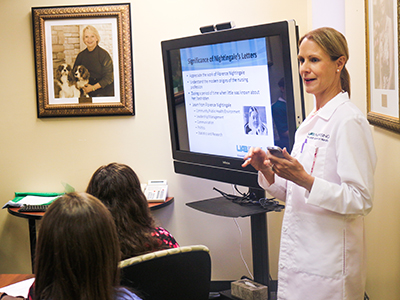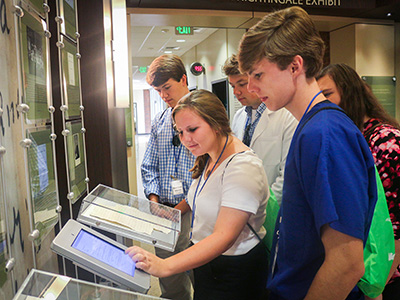Nichols’ poster “Infusing Global Health And Leadership Into Program Curricula With A Florence Nightingale Letter Collection” highlighted one of the true treasures the School and UAB have to offer – a collection of 48 Nightingale letters, most handwritten by or dictated and signed by her between 1853 and 1893.
Housed in UAB’s Reynolds-Finley Historical Library, the original letters were donated to the Medical School in 1958 by native Alabamian Lawrence Reynolds, MD, who paid $450 for them in a New York used bookstore in 1951. They were first brought to life in the School in 2010 when a donation from the Delia and John Robert Trust made it possible for them to be digitized, transcribed and published online and became a true teaching tool in 2012 with the creation of the Barrett Brock MacKay Florence Nightingale Exhibit.
 Associate Professor Dr. Lynn Nichols uses a slide on the significance of Florence Nightingale's letters to make a point to a group of perspective nursing students on a visit to the UAB School of Nursing.
Associate Professor Dr. Lynn Nichols uses a slide on the significance of Florence Nightingale's letters to make a point to a group of perspective nursing students on a visit to the UAB School of Nursing. Thanks to a generous lead donation from Barrett and Rick MacKay and the Harry B. and Jane H. Brock Foundation, the interactive showcase located on the first floor of the School of Nursing puts the Nightingale letters on prominent display for students and faculty and allows Nichols to go back to the future as a teaching technique.
“To have these treasures right across the street and this display here in the School is truly amazing and something that brought me back here as faculty,” Nichols said. “I love the history of nursing, the history of healthcare, how it all fits in and where it began. The opportunity to interact with these letters and do these type of projects was extremely appealing to me.”
Nichols has found that she often has to educate the educator when it comes to using history in a nursing classroom. She said there seems to be a reluctance to bring the past to the present, which she does not understand.
“A lot of people tend to think, ‘it is historical so it is not relevant,’” Nichols said. “These letters show the relevance and also connect us with who we think is the founder of modern nursing.
“There are plenty of lessons that she documented for us in these letters, and we can highlight them and bring them out in the classroom. We don’t always have to recreate the wheel.”
She is happy to see use of the Nightingale collection as a teaching tool increasing in the School.
Students in the School are now introduced to the Nightingale letters during various program orientations and are encouraged to interact with them throughout their courses of study.
Several faculty now make specific course assignments based on the Nightingale collection. For example, students in the NUR 381 Informatics and Research for Nursing Practice for RNs are asked to review the historical perspective of research and discuss Nightingale as the first person to analyze nursing care and patient outcomes.
Nichols has also made presentations to outside groups that have visited the exhibit, including a group of summer campers and perspective nursing students brought to the School by Barrett Brock MacKay.
 The interactive display in the Barrett Brock MacKay Florence Nightingale Exhibit puts the Nightingale Letter Collection at the fingertips of visitors and nursing students alike at the UAB School of Nursing.
The interactive display in the Barrett Brock MacKay Florence Nightingale Exhibit puts the Nightingale Letter Collection at the fingertips of visitors and nursing students alike at the UAB School of Nursing. “The exciting thing is that every student can take away something a little different,” Nichols said. “There are overall lessons to be learned, but everyone can take away some other lessons of their own as well.”
Nichols also has replicas of medical instruments from Nightingale’s day she occasionally uses to enhance her presentations, including a wooden monaural stethoscope and a fleam, a handheld tool used for bloodletting. But it is the Nightingale letters that will always be the focal point when she pushes for the past as she did at the ALN conference.
“It was well received, and two or three schools said they may want to consult with me to help them find a way to use the letters as well,” Nichols said.
There’s one thing she’ll be sure to tell them and hope they grasp above all else.
“I always put in that the price of the letters in 1958 was $450 because I want them to know the value of these letters,” Nichols said. “I always tell them there was a price on them back then, but they are priceless today.”